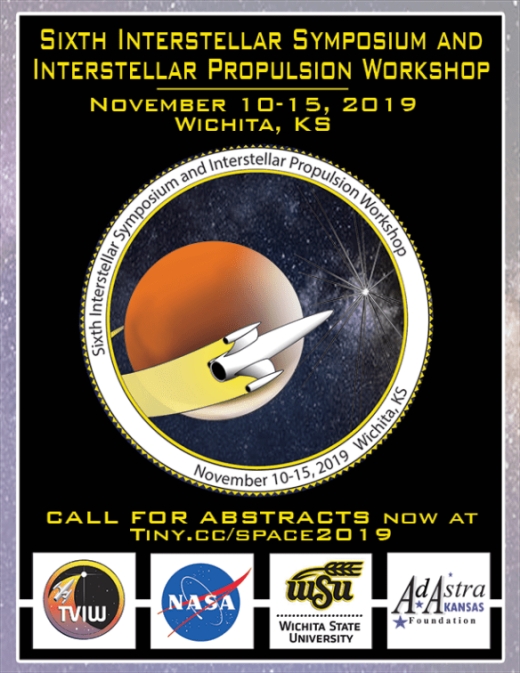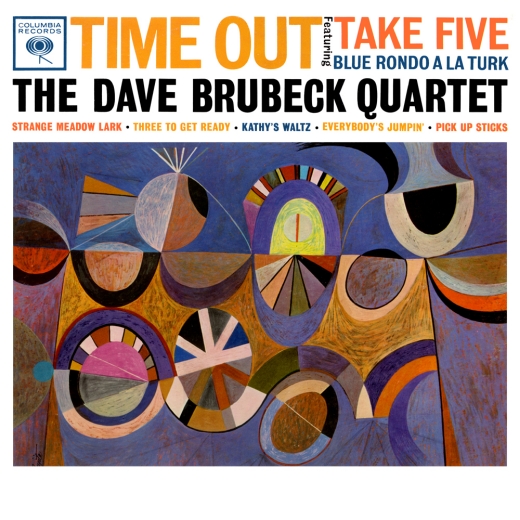Summer Break
And boy do I need it! See you in two weeks.

And boy do I need it! See you in two weeks.


6th Interstellar Symposium and Interstellar Propulsion Workshop – TVIW 2019
In collaboration with the National Aeronautics and Space Administration (NASA), the Tennessee Valley Interstellar Workshop (TVIW) hereby invites participation in its 6th Interstellar Symposium and Interstellar Propulsion Workshop -hosted by Wichita State University (WSU) and Ad Astra Kansas Foundation – to be held from Sunday, November 10 through Friday, November 15, 2019, in Wichita, Kansas. The 2019 TVIW has the following elements:
The NASA Workshop on Interstellar Propulsion will focus solely on physics-based propulsion technologies that have the potential to meet the goal of launching an interstellar probe within the next century and achieving .1c transit velocity: Beamed Energy Propulsion, Fusion, and Antimatter.
At this meeting, the state-of-the-art of each will be examined, competing approaches to advancing the Technology Readiness Level (TRL) of each will be presented by advocates and assessed by non-advocates for synthesis into a workshop report to serve as the blueprint for possible future interstellar propulsion technology development.
The Interstellar Symposium will focus on all other aspects of interstellar travel excluding the advanced propulsion technologies to be covered in the NASA Workshop on Interstellar Propulsion, such as power, communications, system reliability/maintainability, psychology, crew health, anthropology, legal regimes and treaties, ethics, exoplanet science (possible destinations), and related research.
Working Tracks are collaborative, small group discussions around a set of interdisciplinary questions on an interstellar subject with the objective of producing “roadmaps” and/or publications to encourage further developments in the respective topics. This year we will be organizing the Working Tracks to follow selected plenary talks with focused discussions on the same topic.
Sagan Meetings. Carl Sagan famously employed this format for his 1971 conference at the Byurakan Observatory in old Soviet Armenia, which dealt with the Drake Equation. Each Sagan Meeting will invite five speakers to give a short presentation staking out a position on a particular question. These speakers will then form a panel to engage in a lively discussion with the audience on that topic.
Seminars are 3-hour presentations on a single subject, providing an in depth look at that subject. Seminars will be held on Sunday, November 10, 2019, with morning and afternoon sessions. The content must be acceptable to be counted as continuation education credit for those holding a Professional Engineer (PE) certificate.
Other Content includes, but is not limited to, posters, displays of art or models, demonstrations, panel discussions, interviews, or public outreach events.
Publications: Since TVIW serves as a critical incubator of ideas for the interstellar community, we intend to publish the work of TVIW 2019 in many outlets, including a complete workshop proceedings in book form.
No Paper, No Podium: If a written paper is not submitted by the final manuscript deadline, authors will not be permitted to present their work at the event. Papers should be original work that has not been previously published. Select papers may be submitted for professional publication, such as in the Journal of the British Interplanetary Society (JBIS).
Video and Archiving: All TVIW events may be captured on video or in still images for use on the TVIW website, in newsletters and social media. All presenters, speakers and selected participants will be asked to complete a Release Form that grants permission for TVIW to use this content as described.
ABSTRACT SUBMISSION
Abstracts for presented papers/presentations at TVIW 2019 may be submitted to either of two categories:
1. NASA Workshop on Interstellar Propulsion
2. Interstellar Symposium
Topics for Working Tracks, Sagan Meetings, Seminars, and Other Content are NOT solicited at this time.
Abstracts for the NASA Workshop on Interstellar Propulsion must relate to one of the three propulsion technologies of interest (Beamed Energy Propulsion, Fusion, and Antimatter) and should include the aspects of recent research, an assessment of the technology’s Technology Readiness Level (TRL) using NASA’s definitions found here, and a discussion of critical technical issues to be resolved with realistic, near-term technical development milestones identified (including relevant performance metrics).
Abstracts for the Interstellar Symposium must related to one or more of the many other interstellar mission related topics, such as power, communications, system reliability/maintainability, psychology, crew health, anthropology, legal regimes and treaties, ethics, exoplanet science (possible destinations), and propulsion technologies not explicitly called for in the NASA Workshop on Interstellar Propulsion.
Abstracts due: July 30, 2019.
All abstracts must be submitted online here.
PRESENTING AUTHOR(S) – Please list ONLY the author(s) who will actually be in attendance and presenting at the conference. (first name, last name, degree -for example, Susan Smith, MD)
ADDITIONAL AUTHORS – List all authors here, including Presenting Author(s) – (first name, last name, degree(s) – for example, Mary Rockford, RN; Susan Smith, MD; John Jones, PhD)
ABBREVIATIONS within the body should be kept to a minimum and must be defined upon first use in the abstract by placing the abbreviation in parenthesis after the represented full word or phrase. Proprietary drug names and logos may NOT be used. Non-proprietary (generic) names should be used.
ABSTRACT LENGTH – The entire abstract, (EXCLUDING title, authors, presenting author’s institutional affiliation(s), city, state, and text), including any tables or figures should be a maximum of 350 words. It is your responsibility to verify compliance with the length requirement.
Abstract Structure – abstracts must include the following headings:
Questions and responses to this Call for Papers, Workshops and Participation should be directed to: info@tviw.us
For updates on the meeting, speakers, and logistics, please refer to the website: https://tviw.us/2019-symposium/
TVIW is incorporated in the State of Tennessee as a non-profit education organization. TVIW is a tax-exempt, 501(c)(3) educational, non-profit corporation by U.S. Internal Revenue Service. For U.S. tax purposes, all donations to TVIW are fully tax deductible (as allowed by your local laws).
Copyright © 2019 Tennessee Valley Interstellar Workshop, Inc. (TVIW), All rights reserved.


Centauri Dreams posts will unfortunately be sporadic over the next couple of weeks as I attend to some unrelated matters. But I do have several excellent upcoming articles already in the pipeline, including Al Jackson on Apollo 8 at the end of this week. Al, you’ll recall, was involved in Apollo as astronaut trainer on the Lunar Module Simulator, so his thoughts on the program’s extraordinary successes are always a high point.
Image credit: Manchu.
Ashley Baldwin, who knows the ins and outs of space-based astronomy better than anyone I know, will be looking at the key issues involved, with specific reference not only to WFIRST and HabEX but also a mission called EXCEDE, not currently approved but very likely the progenitor of something like it to come.
In early January, Jim Benford will be talking about beamed propulsion in a two-part article that looks to resolve key particle beam issues, with methods worked out by himself and the ingenious Alan Mole. There are all kinds of advantages to particle beaming but doing it without serious beam divergence is a problem we’ve addressed before. A possible solution emerges.
And, of course, we do have Ultima Thule coming up for New Horizons, on New Year’s Eve, no less. Data return including imagery will take some time, so we’ll be talking about the results throughout January. Emily Lakdawalla’s breakdown of the likely schedule gives an overview of the process.
Let me wish you all the best for the holidays. Here’s hoping for spectacular success for New Horizons along the way. Champagne and a working mission in the Kuiper Belt. What a night!

Dave Brubeck’s Time Out album was the first jazz LP I ever bought, just after it came out in 1959, the same year that Miles Davis released Kind of Blue. Watershed moments both. Paul Desmond once said of his alto sax work that he was trying to create the sound of a dry martini, a description I certainly can’t top.
Last night, while listening to Desmond and Brubeck, I realized that the Time Out album would be emblematic for today’s post. For it’s that time of year, and I am indeed taking time out for a much needed break. Centauri Dreams will be back in the first week of August, but until then, my break will include a good bit of jazz, much catch-up reading, a lot of long walks and, perhaps, a few of those martinis Desmond talks about. I’ll keep an eye on the site to handle comment moderation as well. Meanwhile, I hope all of you are having a splendid summer.


Some of you may have noticed a blip in the comments moderation over the past 24 hours. I think all messages have now come through, but a software upgrade on my server is the culprit. Things seem to have gone back to normal now.
On an unrelated matter, I won’t be able to get off a post today or tomorrow. On Tuesday, I’ll have some interesting information about Breakthrough Starshot. [I had originally promised this for Monday, having forgotten about the US holiday].

Several readers have told me that their email deliveries of Centauri Dreams have not been coming through. This has been an on-again, off-again problem for some time and I’m now trying to switch providers to take care of it. Bear with me, as I hope to have the problem resolved within a few days.
